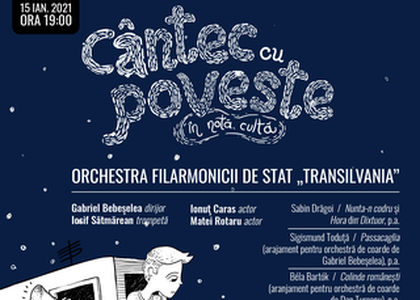> [Archived] Events

High Classic Transylvania
High Classic Transylvania is a project which combines history with classical music, on a unique journey of rediscovering a part of Transylvania's cultural heritage, namely castles and medieval religious edifices. The project is a joint venture between the "Transylvania" State Philharmonic and the National Museum of Transylvanian History, and it is carried out with the help of the Cluj County Council, the Transylvania Philharmonic Society and Ikon.
High Classic Transylvania consists of 7 episodes, each of them approximately 20 minutes long, during which the audience is presented with the story of one cultural edifice from Transylvania, with a beautiful ambience provided by classical music. The repertoire is chosen so that it is suggestive either for the type of cultural edifice, either for the period it was built in, or for its role. The project was filmed last summer, and followed by a period of significant labour for editing, as well as sound and video montage, in order for the first episode of the series to be broadcasted on January 1st 2021 on the Facebook pages of the institutions involved in the project.
The travel through time began on the sound of hunting music. The first episode of this project weaved together the story of one of the most beautiful hunting castles on ValeaSomeșului - the Teleki Castle from Luna de Jos - and five wonderful pieces of classical music from the hunting repertoire, performed by the horn players from the "Transylvania" State Philharmonic Orchestra. The castle, once finished, was burned down in an act of revenge by the imperialists on its owner, a supporter of the reformed church. Thus, the only element that still stands after this event is the hunting tower, still visible today.
Episode 1 can be watched here:
https://www.youtube.com/watch?v=vrS2bycKnOM
The second episode aired Tuesday, January 12th, switching the register from secular to religious, by reflecting the story of the Reformed Church of Nima. Towards the end of the Nima village, after climbing a little hill, you reach a small church made of stone, which has been standing for about eight centuries already, but which few people still remember today. In the grass surrounding it sit old crosses and gravestones, either straight or crooked, that speak about those who once prayed here.
Inside it you can still see parts of the original frescoes depicting biblical scenes, discoloured by the time, dated somewhere around the beginning of the 14th century. Nowadays the church is not in use. It sits lonely, a true gem of Transylvanian architecture, a narrow, simple place, of utmost spiritual intimacy, but out of which the voices of the "Transylvania" State Philharmonic's choir have echoed unbounded.
Episode 2 can be watched here:
https://www.youtube.com/watch?v=JfYIqd8HlWI
Because we are trying to showcase the diversity of the Transylvanian cultural heritage, the next episode will take the audience in an entirely different place, both historically, and musically. It is about the magnificent Kornis castle from the Mănăstirea village, whose story will unfold on the shining sound of the Brass Quintet from the "Transylvania" State Philharmonic. Episode 3 is scheduled for January 26th.
Going forward, the schedule of the episodes will be every two weeks on Tuesdays at 8 PM, online, on the Facebook pages of the: "Transylvania" State Philharmonic, National Museum of Transylvanian History and Radio RomâniaMuzical. The series is also broadcasted on the "Transylvania" State Philharmonic's YouTube channel.
Coming up:
The Evangelical Church from Herina;
The Medieval Churches from Jelna and Moruț (both in the same episode);
The Bánffy Castle from Răscruci;
The Haller Castle from Coplean ("the seashells castle").
About the project:
Project team (alphabetically):
Oana Andreica- musical advisory, texts, organization;
Csók Zsolt (archaeologist, MNIT) -documentation, texts, narration, organization;
Köpeczi Sándor-Attila -musical advisory, organization;
Rareș Sângeorzan-musical advisory, organization;
Geanina Simion - concept, image, text adaptations, organization.
Translated and adapted by: Juliánna Köpeczi
Recording, editing and sound montage by: Ion Marina-Uifălean.
Editing and video montage by: We Are Studio.
Photo: Cristina Rădulescu
Drone filming: Lucian Marica.
Presented by:
Csók Zsolt, archaeologist, MNIT
Translated by Teliban Cătălina-Diana,
University of Bucharest, Faculty of Foreign Languages and Literatures, MTTLC, Year II
Corrected by Silvia Petrescu














